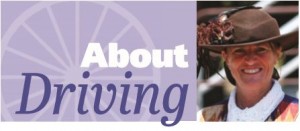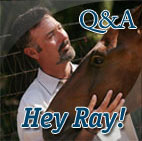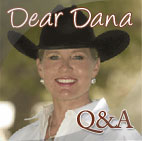Proper equitation and position on the box seat
The hands and contact. As a driver, there is a lot to think about. It’s not just hitching up an equine and going down the road behind the horse, holding the lines. It’s your responsibility to understand if your horse is harnessed and hitched correctly to avoid any mishaps along the way. I HOPE one of the first things you will learn is proper control of your horse through your hands and posture.
Driving problems: It’s all in the proper adjustment
 When you have been exposed to driving as much as I have, you tend to see the same issues with harnessing, adjustment, and form-to-function almost every time you see someone driving.
When you have been exposed to driving as much as I have, you tend to see the same issues with harnessing, adjustment, and form-to-function almost every time you see someone driving.
When a harness and vehicle are properly adjusted to each other, the effect should be that the horse leans into the collar and can immediately be in draught, or lean back and be into the breeching. If the traces or breeching are incorrectly adjusted, then too much slop and slack is created that can be annoying to the equine trying to do his job.
CAA Driver Proficiency Program makes the grade
 Now that you drive confidently and have educated yourself with lessons, books and articles, what can you DO with all of that knowledge?
Now that you drive confidently and have educated yourself with lessons, books and articles, what can you DO with all of that knowledge?
There is a great program available to evaluate all that gained knowledge. It’s very similar to Pony Club. You work upward through the levels of requirements by being evaluated and rewarded for your knowledge. You receive a certificate for each level that you achieve, and a lapel pin for bragging rights. The Carriage Association of America’s (CAA) Driver Proficiency Program (DPP) is an excellent opportunity for recreational and professional drivers alike to put a framework to their carriage driving skills and knowledge. Knowledge and recognition can reduce your liability through safe practices.
Getting to know ‘Cones’
 In my previous articles, I’ve explained about the first two phases of combined driving events (CDE), which are driven dressage and marathon. Now, we’ll learn about the final phase of the event: cones.
In my previous articles, I’ve explained about the first two phases of combined driving events (CDE), which are driven dressage and marathon. Now, we’ll learn about the final phase of the event: cones.
The objectives are to test the fitness, obedience, soundness and suppleness of the horses — after competing on the marathon — and to test the skill and competence of the driver. This is a timed-fault competition based on penalties for cones/balls knocked down and for exceeding the time allowed on course. Tennis balls or special weighted balls are placed upon the tops of cones. If a cone or ball is knocked over or dislodged, a five-second time penalty is added to the time on course. There are also penalties or disqualification for various other infractions.
Answering your common driving questions
 Here are some answers to common questions in driving:
Here are some answers to common questions in driving:
How do I choose a horse for driving?
The breed of the horse isn’t important, nor is the size important, other than finding the perfect horse for the job intended. My first requirement is the horse shouldn’t go into full training until it’s mature enough mentally and physically to do so. Personally, I usually like to start a horse at age 3 or older. Next, I look for a good mind and calm attitude. I want a willing and obedient equine, who will take to training. It should be sound with fair conformation. Older, well trained saddle horses, often take to driving training quite well.
The marathon phase of combined driving: Thrilling
 In my last article, I discussed driven dressage, which is typically phase one (or day one) of combined driving events (CDEs). This is an overview of phase two (or day two) of competition: the marathon.
In my last article, I discussed driven dressage, which is typically phase one (or day one) of combined driving events (CDEs). This is an overview of phase two (or day two) of competition: the marathon.
The origins of CDEs started in the 1970s in Europe, and Prince Phillip of England was an early supporter and competitor who helped establish the rules of the sport. It is based upon the ridden three-day eventing sport that includes dressage, cross country roads and tracks with jumps, and stadium jumping. Since jumping in carriages is greatly discouraged, instead of going over the jumps, carriages drive around the jumps, or “obstacles,” which were called “hazards” in the old days.
Driven Dressage: What’s it all about?
 What is driven dressage, and WHY are so many drivers intimidated by it?
What is driven dressage, and WHY are so many drivers intimidated by it?
Dressage is a systematic training for every horse and discipline through progressive exercises. I believe that many people are confused about the concepts and how it can help them achieve their goals in competition. The structure of the levels – training through advanced – is meant to guide the horse through its training in a progressive manner, and every horse should be give the time to work honestly through these steps. Taking shortcuts means skipping or failing to develop any one of the qualities in the training scale. Shortcuts result in the improper physical and mental development of the horse. One way to help is by following the German Training Scale, as explained later in this column.
History of carriage turnout: the WOW factor
 Private carriages have been around for hundreds of years. In the beginning, they were status symbols of the times, as only the very wealthy could afford them. The whole “turnout” was reflective of status and wealth. From the horses, their harness, the footmen and their livery or special clothes to the vehicle itself, it all made an impression to the average person, as if to say, “Look at ME, I’m SPECIAL!”
Private carriages have been around for hundreds of years. In the beginning, they were status symbols of the times, as only the very wealthy could afford them. The whole “turnout” was reflective of status and wealth. From the horses, their harness, the footmen and their livery or special clothes to the vehicle itself, it all made an impression to the average person, as if to say, “Look at ME, I’m SPECIAL!”
So what does this have to do with modern driving? It’s all about the history and traditions of the past!
A definition of turnout might be this: Harmony of detail, quietness of color and ornamentation, appropriateness of vehicle and equipment — competent for the purpose intended. Most aspects of a turnout that are not purely practical are influenced by fashion, convention, and tradition. A fashion can be fleeting, but if it sticks around long enough, it becomes convention. A fashion is a whim that is introduced by a notable person and copied by others. A fashion that lasts more than 10 years usually has a practical side and becomes a convention, which then after a long number of years (decades) becomes tradition, and is thus hallowed and zealously preserved.
Taking a drive through our sport’s history
Many towns were developed at about eight-mile intervals. Why? That was how far the average horse trotted between rests...
 The history of America is linked with the history of horse-drawn power, particularly the expansion of road networks from the late 1700s forward. It created a need for business hubs to distribute people, freight, goods and services. Many towns were developed at about eight-mile intervals. Why? That was how far the average horse trotted between rests, feed (refueling) and watering. Everything about the production and consumption of draft animals shaped the material environment. Innovations were constantly in the forefront to help the equine work more efficiently — better roads, harnesses, vehicle design, feed, veterinary care, and shoeing. The driven horse, mule and ox were the “engines” that moved and improved America during the industrial revolution. Energy demands of industrialization increased American’s dependence on horses, mules and oxen. The horse population grew in size but began to change in composition. More and varying sizes, breeds, and strengths of equines were needed. During the 19th century, the approaches taken by horse breeders reshaped horses to fit the needs of society. They transformed the bodies of horses as well as their uses.
The history of America is linked with the history of horse-drawn power, particularly the expansion of road networks from the late 1700s forward. It created a need for business hubs to distribute people, freight, goods and services. Many towns were developed at about eight-mile intervals. Why? That was how far the average horse trotted between rests, feed (refueling) and watering. Everything about the production and consumption of draft animals shaped the material environment. Innovations were constantly in the forefront to help the equine work more efficiently — better roads, harnesses, vehicle design, feed, veterinary care, and shoeing. The driven horse, mule and ox were the “engines” that moved and improved America during the industrial revolution. Energy demands of industrialization increased American’s dependence on horses, mules and oxen. The horse population grew in size but began to change in composition. More and varying sizes, breeds, and strengths of equines were needed. During the 19th century, the approaches taken by horse breeders reshaped horses to fit the needs of society. They transformed the bodies of horses as well as their uses.
Whoa! Is the most important word a driving horse knows
 Every time I work with a new horse, I learn something. After getting to know the horse in the round pen, the first things I teach the horse is to walk, whoa , and to stand on command.
Every time I work with a new horse, I learn something. After getting to know the horse in the round pen, the first things I teach the horse is to walk, whoa , and to stand on command.
This introductory part of training is very important for building trust and mutual respect between horse and trainer. Time and patience is needed. Nothing will be gained if the trainer loses his patience and the horse gets frightened or resistant.
WHOA is the most important word a driving horse needs to know. It’s never used in driving to slow a horse — it means STOP all movement. Stand is the next important word your horse must learn. You stop at the stop sign, but the horse must stand until asked to move forward!



 Read Columns
Read Columns

